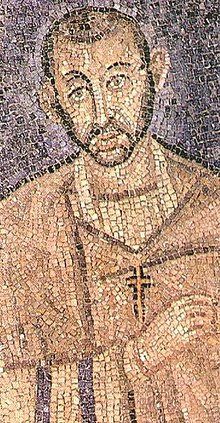De bono mortis
A companion piece or supplement to his De Iacob, it was composed "as two sermons, perhaps for the catechumens awaiting baptism at Easter".
[2] Profoundly informed by neoplatonism, it is one of the texts through which Augustine of Hippo, Ambrose's pupil in Milan, came under the influence of that philosophy.
[4] According to Pierre Hadot, Ambrose derives this doctrine to a great extent from Origen; his neo-platonism—the language of Plato and Plotinus he received through Porphyry.
[6] One of the medieval codices that contains De bono mortis is the eighth-century Ragyndrudis Codex, a collection traditionally thought to have been used by Saint Boniface to protect himself during his martyrdom in 754.
[9] Both those editions are based on the 1896 Latin text by Karl Schenkl for the Corpus Scriptorum Ecclesiasticorum Latinorum,[8][9] as is the Catholic University's translation of seven of Ambrose's works, including De bono mortis.
